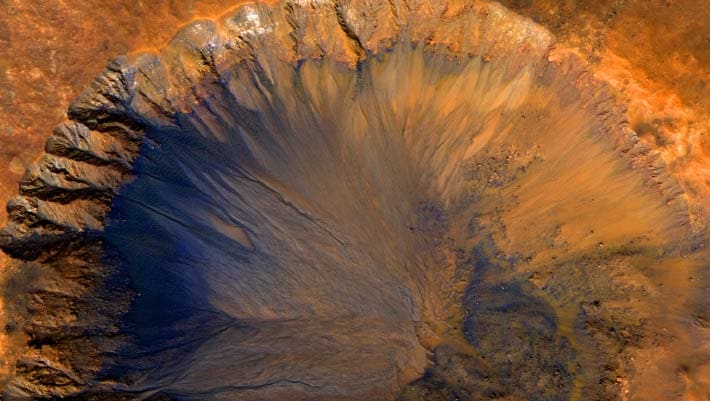Slope streaks are dark features on Martian slopes that form spontaneously and fade over years to decades. Some planetary scientists have interpreted those streaks as liquid flows, suggesting the possibility of currently habitable environments on Mars. But new research by Brown University and the University of Bern points to a different explanation — dry process related to wind and dust activity.

This image of an impact crater in the Sirenum Fossae region of Mars was taken by NASA’s Mars Reconnaissance Orbiter on March 30, 2015. The crater is approximately 3,300 feet (1-km) wide and appears relatively recent as it has a sharp rim and well-preserved ejecta. The steep inner slopes are carved by gullies and include possible recurring slope lineae on the equator-facing slopes. Image credit: NASA / JPL / University of Arizona / Alfred McEwen.
“A big focus of Mars research is understanding modern-day processes on Mars — including the possibility of liquid water on the surface,” said Dr. Adomas Valantinas, a postdoctoral researcher at Brown University.
“Our study reviewed these features but found no evidence of water. Our model favors dry formation processes.”
Scientists first saw the odd streaks in images returned from NASA’s Viking mission in the 1970s.
The sinewy features are generally darker in hue than the surrounding terrain and extend for hundreds of meters down sloped terrain.
Some last for years or decades, while others come and go more quickly.
The shorter-lived features — dubbed recurring slope lineae (RSL) — seem to show up in the same locations during the warmest periods of the Martian year.
The origin of the streaks has been a hot topic among planetary scientists.
Hoping for new insights, Dr. Valantinas and his colleague, Dr. Valentin Bickel, turned to a machine learning algorithm to catalog as many slope streaks as they could.
After training their algorithm on confirmed slope streak sightings, they used it to scan more than 86,000 high-resolution satellite images.
The result was a first-of-its-kind global Martian map of slope streaks containing more than 500,000 streak features.
“Once we had this global map, we could compare it to databases and catalogs of other things like temperature, wind speed, hydration, rock slide activity and other factors,” Dr. Bickel said.
“Then we could look for correlations over hundreds of thousands of cases to better understand the conditions under which these features form.”
This geostatistical analysis showed that slope streaks and RSLs are not generally associated with factors that suggest a liquid or frost origin, such as a specific slope orientation, high surface temperature fluctuations or high humidity.
Instead, the authors found that both features are more likely to form in places with above average wind speed and dust deposition — factors that point to a dry origin.
The researchers concluded that the streaks most likely form when layers of fine dust suddenly slide off steep slopes.
The specific triggers may vary. Slope streaks appear more common near recent impact craters, where shockwaves might shake loose surface dust. RSLs, meanwhile, are more often found in places where dust devils or rockfalls are frequent.
Taken together, the results cast new doubt on slope streaks and RSLs as habitable environments.
That has significant implications for future Mars exploration.
While habitable environments might sound like good exploration targets, NASA would rather keep its distance.
Any Earthly microbes that may have hitched a ride on a spacecraft could contaminate habitable Martian environments, complicating the search for Mars-based life.
This study suggests that the contamination risk at slope streak sites isn’t much of a concern.
“That’s the advantage of this big data approach,” Dr. Valantinas said.
“It helps us to rule out some hypotheses from orbit before we send spacecraft to explore.”
The results were published on May 19, 2025 in the journal Nature Communications.
_____
V.T. Bickel & A. Valantinas. 2025. Streaks on Martian slopes are dry. Nat Commun 16, 4315; doi: 10.1038/s41467-025-59395-w


